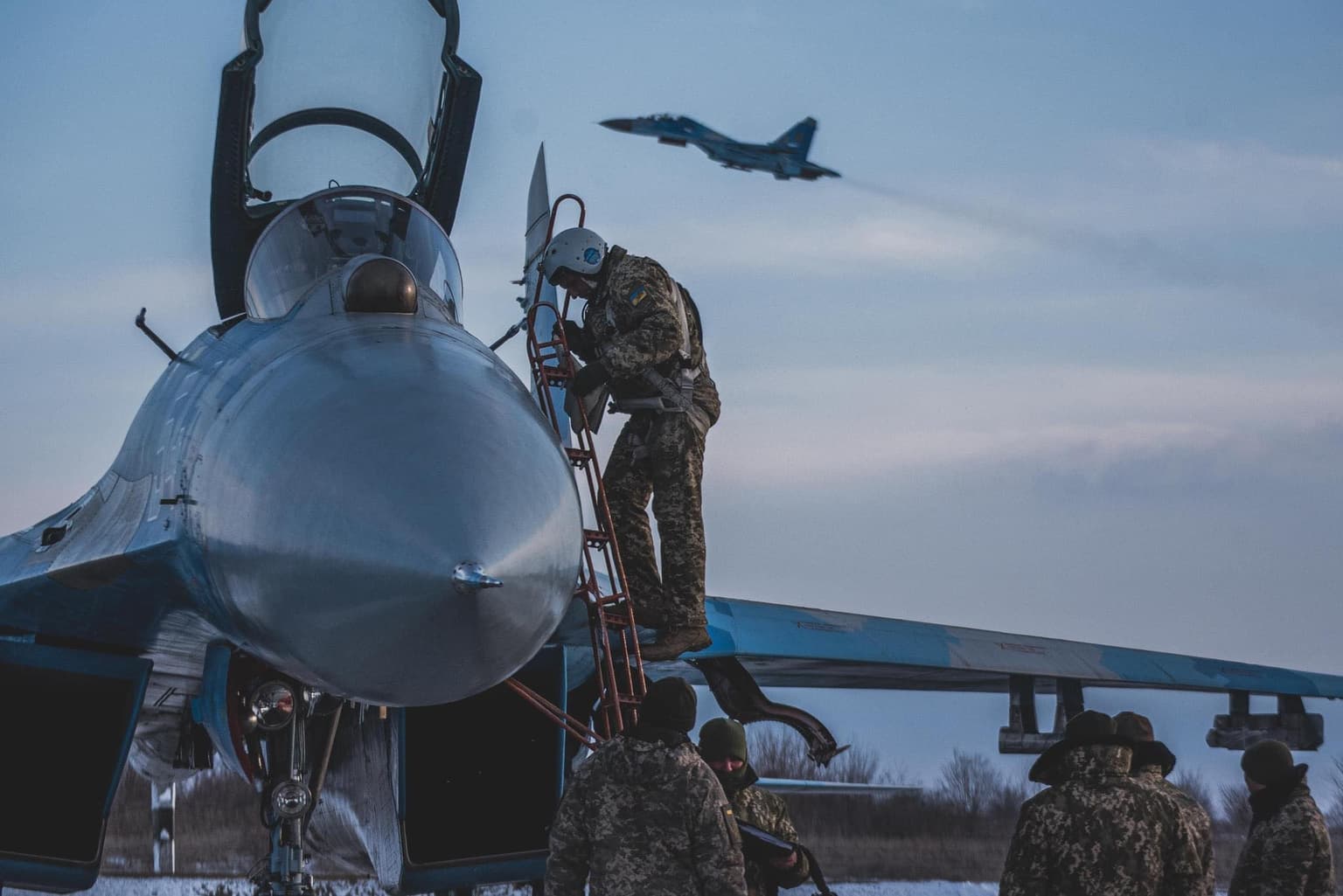Center for Defense Strategies: How likely is large-scale war in Ukraine? (analysis)

Editor's note: This is an analysis by the Center of Defense Strategies' experts Andriy Zagorodnyuk, Alina Frolova, Oleksiy Pavliuchyk. It was originally published in Ukrainian by Ukrainska Pravda. The Kyiv Independent has translated it and is republishing it with permission.
Many politicians and observers report that a significant escalation of military aggression by Russia is highly probable.
Various scenarios are mentioned, in particular the widely discussed scenario of a full-scale military operation with the capture of either a large part of Ukraine or the whole country.
Western politicians and experts are actively discussing this scenario. There is talk of it happening in the coming weeks, or even days.
How realistic is such an invasion, and what will most likely happen?
In short, our conclusions are the following:
- A full-scale invasion capturing most or all of Ukraine in the near future seems unlikely.
- There are other threatening scenarios that may materialize.
- Ukraine must remain calm and actively prepare for the defense of the country in any case.
The current situation is very complex and extremely dynamic. Every day there is new data that impacts the forecast. Therefore, we are ready to update our position in the near future, should new data emerge.
Let's try to understand what’s happening in detail:
How realistic is the scenario of a full-scale offensive into all or most of Ukraine in the near future?
At the moment, there are not enough Russian troops on Ukraine's borders and no fully formed military groups needed to conduct a strategic offensive against Ukraine.
According to our estimates, supported by many of the indicators below, a large-scale general military operation can’t take place for at least the next two or three weeks.
As of Jan. 23, we do not observe the required formation of several hundred thousand troops, not only on the border with Ukraine, but also on Russian territory behind the front line.
Besides, we do not see the creation of strategic reserve units, nor the mobilization of the necessary connections and units on the basis of the centers for mobilization deployment.
Russian troops move mainly as battalion tactical groups (mechanized, tank and airborne troops) and tactical groups (artillery, multiple launch missile systems).
Russia hasn’t completed the formation of groups of troops in operational areas. It also hasn’t established and tested its wartime administration system.
If Russia was conducting preparations for a large-scale invasion, it would have been much more noticeable.
Therefore, what we currently have is the military threat posed by about 127,000 Russian servicemen along Ukraine's borders, in the occupied territories of eastern Ukraine, and in Crimea. This number has not increased since April, and is not enough for a full-scale offensive.
At the same time, Russia could add more troops near Ukraine’s borders by:
- assembling new formations and units in the Southern and Western military districts of Russia;
- transferring troops to Belarus for exercises;
- deploying land forces, the Navy and the airborne forces to military training grounds near the border of Ukraine and in occupied Crimea;
- increasing the number of Russian troops 150-300 kilometers away from the state border of Ukraine.
The number of Russian troops along the borders can be significantly increased by transferring units and groups of constant combat readiness, which have the appropriate combat experience and the necessary skills to act in unfamiliar territories. But this also takes some time.
At the same time, according to available information, Russia’s National Guard units conducted a series of combat training in Belarus and occupied Crimea throughout 2021.
This may indicate Russia’s preparation for actions in the occupied territories, especially in eastern Ukraine. Similarly, active measures are being taken to accumulate stocks of food, fuels and lubricants, and other material resources for the Russian army.
One of the indicators of Russia's preparation for an attack is the number of mobile hospitals being deployed, and the speed of staffing medical units. At present, there is no evidence of the readiness of medical infrastructure to participate in a possible operation by the Russian armed forces.
In general, according to experts, all the critical indicators and intelligence indicators that characterize the completion of the Russian army's preparations for a large-scale offensive strategic operation have not yet emerged.
To sum up, Russia is currently short of forces and resources to carry out a large-scale operation, and does not demonstrate the necessary concentration of all available combat-ready forces, which requires time and a significant amount of measures and resources.
How likely is an invasion in 2022?
In general, a large-scale Russian offensive operation against Ukraine in 2022 seems unlikely according to many indicators, even judging by purely military requirements.
Firstly, this is evidenced by a lack of the required number of troops for such an operation, which should be in the hundreds of thousands of trained military contractors capable of participating in active hostilities against Ukraine.
Secondly, there would be a need train and coordinate the newly formed military groups, and ensure a reliable system for managing them.
Thirdly, there is the need to provide troops with weapons and military equipment, including ammunition, fuel and lubricants. This requires strategic reserves and reliable logistics, including in the occupied territories.
Fourthly, there is Russia’s questionable ability to hold occupied territories amid national resistance, where the combat experience of many Ukrainians greatly surpasses that of Russian troops who fought in Syria, or in other armed conflicts in recent decades.
Overall, a large-scale offensive operation with an attempt to hold large occupied territories is a gamble that has no chance of a positive outcome for Russia. It is impossible to calculate the course of such an operation, and when implemented, it will quickly move to an uncontrollable point.
When we add non-military components to this formula, such as international isolation and sanctions, then the result of an invasion will be politically suicidal for the Kremlin. We believe that, if Putin and his team have not lost their ability to think rationally, they will not go for such a scenario.
What are the likely scenarios?
Given the dynamics, we see the possibility for the following scenarios, which can be implemented separately or concurrently:
- A Hybrid invasion is the baseline scenario. It is already being implemented, and will be the primary option for any further options.
This would consist of cyberattacks, which are already taking place, and the forecast is that they will intensify further. These would also be psychological operations, such as active disinformation, mass bomb threats at schools, subway systems, administrative offices, and other facilities, along with the spread of disinformation and other methods.
Unfortunately, there is a very high probability of such an escalation.
- In case of an increase of activity, critical infrastructure may be damaged or meddled with - power plants, mobile communications, internet, government communications, transport.
The key goal of such operations is internal destabilization and demoralization of the population.
The goal may also be to psychologically exhaust members of law enforcement, military, and the population as a whole due to the constant high threat level and periodic exacerbations. The level of escalation can be quickly increased. This can be both a basic form of hybrid warfare and a preparation for even more active hostilities.
- A large-scale armed escalation in eastern Ukraine with the official entrance of the Russian armed forces into territories currently under occupation is very real. Attempts to break the Ukrainian lines and a general intensification of hostilities are possible.
The reason for such an escalation may be a fabricated justification, such as a false-flag operation, which will result in the death of Russian citizens in the Kremlin-occupied territories or a terrorist attack "on behalf" of Ukraine.
All these are provocations, and Ukraine does not plan any aggressive actions, but it can be blamed for anything convenient. This scenario is actively being discussed as a possibility by the governments of Ukraine's partners.
- A significant aggravation of the security situation in the Azov and Black Sea region, involving the blocking of the Kerch Strait and Ukraine's sea routes, is also likely. This will hinder the country's economic activity.
These scenarios, which have been mentioned for the past two years, may include the occupation of Zmiyniy Island in the Black Sea, close to the Romanian border, or, for example, a group landing (or a demonstration of readiness to land) on the Black Sea coast to distract from or assist with other scenarios.
- Carrying out terrorist attacks in Ukraine, primarily on critical infrastructure objects.
Such a scenario could be carried out on several sites at the same time to spread panic among the population and distract the authorities.
- Using Belarusian territory for the deployment of Russian troops, possibly on a permanent basis.
Given the current movement of troops under the pretext of joint exercises, such a scenario is very likely. Troops stationed in Belarus can carry out various provocations and actions against Ukraine. The use of Russian troops stationed in Moldova’s occupied Transnistria region is also probable.
- Potentially possible missile or air strikes on military or critical infrastructure as part of preparations for a limited ground invasion and provoking a response from the Ukrainian Armed Forces, or as stand-alone measures to create panic among the population.
Are seizures of individual cities likely?
Russian forces are sufficient to capture certain cities in Ukraine. However, the seizure of key cities by the Russian armed forces is unlikely due to the high complexity of their maintenance, limited options for supply, and the possibility of encirclement of such cities by the Ukrainian armed forces, as well as active resistance, which could destroy or significantly damage any occupying forces.
From a practical point of view, capturing cities will not give political advantages to the Kremlin, but will instead bring a negative public outcry against Russia -- the active response of Ukraine’s defense forces, citizens, and international community which will intensify support for Ukraine and impose sanctions. Therefore we see no point in this action, and no benefits for the Kremlin in such scenarios.
But special attention should be paid to strengthening Kyiv's defenses.
The capital is critical as a strategic center of governance, a concentration point of a large number of critical infrastructures, as well as Ukraine's financial, economic and political center.
The advantages of a blockade of Kyiv can significantly outweigh the cost of losses in personnel in the eyes of Russia.
This means we have to give the highest priority to the defense of the capital, including through reinforcements by the Armed Forces, including the Territorial Defense Forces, the National Guard, law enforcement, security forces, and the widespread involvement of local citizens.
Diplomatic front
Fierce battles are already taking place on the diplomatic front.
Ukraine's diplomats are working hard to significantly increase emergency assistance from partner countries, which will strengthen Ukrainian capabilities. The country is backed by former servicemen and diplomats in the West, as well as think-tanks, who are focusing their efforts on consolidating support.
A number of Western governments are actively supporting Ukraine. A key partner, the United States, provided a record-breaking $650 million in security assistance last year and intends to significantly increase it this year.
The United Kingdom is actively helping us to develop the Ukrainian Navy, and has recently provided us with anti-tank weapons.
Canada, Poland, Estonia, Lithuania, Latvia and Turkey have also proved invaluable in strengthening Ukraine's defense capabilities.
How can Ukraine defend itself?
Ukraine has significant domestic potential for self-defense against any of the realistic scenarios of a Russian attack.
First of all, Ukraine has an army, supported at its rear by territorial defense units and other components of the Defense and Security Forces. With coordinated and rapid action, they are able to stop the enemy and inflict significant losses on them, or destroy them completely.
The strength of Ukraine’s civil society is its competitive advantage over Russia. The Ukrainian people are able to resist the occupying power's troops, including through asymmetric actions such as resistance movements and tactics of small groups, activities in the media and cyberspace.
When preparing for armed struggle, it is important to promptly inform the population and involve them in active actions to reduce panic and ensure psychological resilience.
So, first of all, Ukrainians need to stay calm, collected, and determined. This is extremely important. Calmness must be maintained in any case, because Russia expects to cause panic and despair. This is what most of the hybrid operations aim to do.
The probability of a large-scale offensive will be much higher if the enemy feels psychologically stronger.
Ukrainians must preserve common sense, think critically, and resist misinformation and possible disruptions of normal life, including through hybrid attacks on critical infrastructure. Ukraine knows how to do it – it has been at war for eight years.
Russia's threat to Ukraine is systemic, and as long as this threat is there, Ukrainians must learn to live with it without losing their minds.
Calmness and determination increase significantly when there is self-confidence. In order to have this confidence, it is necessary to understand that Ukraine's armed forces, together with their partners and with the support of the people's resistance, are able to prevent the successful capture of Ukraine's territory and individual regions.
And it must be understood that the country takes the threat seriously and is preparing for it – preparing right now, and doing it seriously.
The country must prepare for war. Readiness is critically important.
Ukraine's armed forces will withstand and neutralize the enemy if they are ready for an attack. When Russia sees their readiness, it will look for other options to achieve its goals, but will avoid a large-scale advance into Ukrainian territory.
This is the core idea of deterrence, which prevails in the defense doctrines of every country. "If you want peace, prepare for war," bears direct relevance to Ukraine's predicament. We cannot afford to be frivolous. As the military says, “hoping for the best” is not a strategy.
But the army and other defense and security forces aren’t the only ones who need to be preparing. This also concerns citizens, local communities, businesses, and everybody else.
The armed forces are ready to repel the enemy as much as they can. They can do a lot, but they are not enough to stop the enemy completely.
Time is a non-renewable resource, and we must use it as efficiently as possible. When active action begins, we won’t have time – we must take all the necessary measures now.
Among the measures recommended by experts are the following:
- deployment of territorial defense forces in the necessary regions;
- deployment of reservists, the National Guard and the State Border Guard Service of Ukraine;
- strengthening control over critical infrastructure facilities, especially those that ensure the livelihood of the population in winter conditions;
- building the capacity of the State Emergency Service and the State Special Transport Service to protect vital infrastructure, strengthening security, including air defense, airports, airfields, patrolling potential enemy landing sites, which could serve as enemy landing areas;
- taking measures to prevent the rapid advance of enemy raids in all possible directions, preparing bridges and other overpasses for destruction, accumulating of stocks of materials to create junctions, areas and barrier zones, preparing for blocking roads from the northern and northeastern borders to Kyiv;
- introduction of protocols in case of cellular and internet shutdown, communication with the population regarding necessary actions in critical situations, determining the responsible authority for the population to turn to in case of crisis;
- it is necessary to train state bodies in crisis response.
There are many more such tasks.
The ability of Ukraine's civil society to participate in the country's defense is critical. The resilience of institutions is important, but so is the resilience of communities and people. About a third of Ukrainian citizens are currently ready to support resistance efforts.
Psychological resilience to sabotage operations and misinformation is key.
Finally, in the face of the external threat, in the spirit of the recent Day of Unity, it is important and necessary to put aside domestic political arguments and stand up together to defend Ukraine, its sovereignty, and statehood. Today, togetherness is more important than individual battles.
A strong, determined, focused country with a calm and informed population, united society, and strong defense forces which are systematically and confidently prepared to repel their enemy, is invincible.
The authors thank the experts of the Center for Defense Strategies (including Col. V. Kevlyuk, Alexander Harry and Hans Peter Midtun) and external reviewers (military, civilian and diplomats), both Ukrainians and representatives of other countries, who contributed to the creation of this document.









